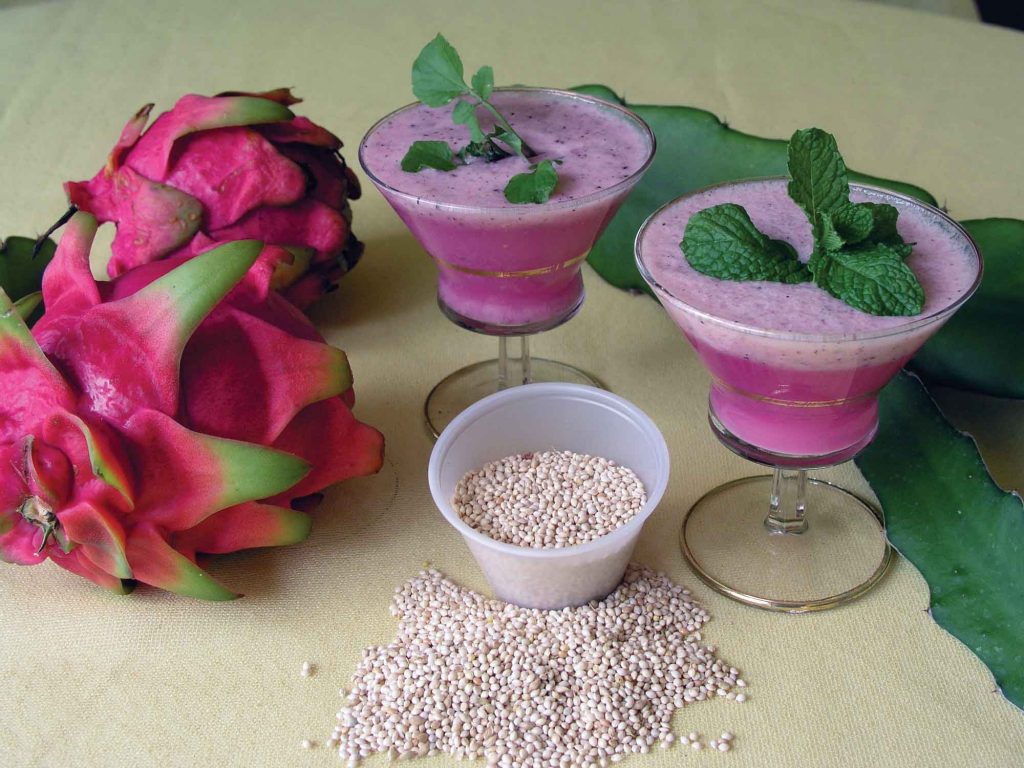Eragrostis tef F. Poaceae
Description and Sprouting
A hardy, annual grain 40-100cm high, with linear-shaped leaves, long flower panicles, which fill out to become the ear of millet seed. Seeds are round, hard, beige-coloured, the size of pinheads. Millet (also called Teff) is used as a soil conditioner, in a wide range of soils.

To sprout millet purchase unhusked seed from a farm produce store (as husked seed from a health food shop may have the germ injured, or scraped off in processing). Soak seeds 5-7 hours, sprout in a jar, sprouter or bag. I use a saucer when wishing to use the sprouts to make juice for drinks. When requiring sprouts as a cereal and in baked recipes, grow to 1/2cm long.
Constituents:
oils, lecithin, coenzyme Q10, salicic acid, lignans, fibre, protein 13% with 8 essential amino acids (amino acid score 38, moderately low in lysine)
Vitamins:
A, B1, B2, B3, B5, B6, B15, B17, C, K, choline, folic acid
Minerals:
boron, calcium, copper, iron, magnesium, manganese, molybdenum, phosphorus, selenium, silicon, sodium
Actions:
anti-inflammatory, aperient, digestive, nervine, nutritive, tonic
Medicinal Uses
Porridge of millet makes a warming, pain-relieving poultice for rheumatism and arthritis. The poultice is applied hot and stimulates the circulation. Millet is easy to digest and has been a food for babies, children and the elderly, for eons. As millet is easy to digest, it does not ferment in the stomach, causing intestinal distress, as do many devitalised grains. It is of interest to read, after World War I, millions of Russian peasants faced starvation, and in desperation, they ate the millet, which had been put away for the hens that they no longer had. Not only did these people survive the long famine, but they soon discovered they were enjoying better health than they had ever known while consuming their former, varied diet. One of the men had suffered from stomach ulcers for 15 years, found that his ulcers disappeared completely in 6 months on his forced diet of nothing but millet.
Being a gluten free grain, it is an ideal food for gluten sensitive people. The grain is valued for promoting strength and energy. Millet contains the highest calcium content of all grains, has less phytates than other grains, is rich in B vitamins and iron, and is very alkaline. Start using millet as a food and sprouts, and get the benefits of this alkaline food. It is believed, that the balance of nutrients in the grain, makes it easily absorbed. Millet is a rich source of silicic acid, which has powerful constructive and supportive functions, and together with calcium, it is able to strengthen and reconstruct connective tissue. When eaten regularly, millet has been found to provide natural rebuilding of bone cartilage, joint surfaces and connective tissue, with better cushioning function of synovial fluid between the joints, showing that joint pain may be progressively relieved, giving relief to arthritic sufferers and other painful conditions. Also, it is believed that the structural protein as collagen in millet, provides elasticity, to bone and cartilage, when it is eaten, together with a balanced whole-food natural diet (with the elimination of processed demineralised foods). As millet provides a soothing and gentle action to the intestines, it is used as a substitute for wheat and oat bran, which can be rather abrasive for some people with bowel conditions.
Culinary Uses
Sprouts taste sweet, are succulent and crunchy, requiring chewing. These sprouts, being hard to chew and difficult for some people to digest raw, are best lightly steamed or added to cooked dishes. When lightly cooked, sprouts make a nutritious breakfast cereal. Add sprouts to soups, casseroles, tomato dishes, breads and muffins. To juice the sprouts grown to the 2-4cm long, at the green-leaf stage, use a wheatgrass juicer. If using a food processor for juicing, put the pulp in a sieve to separate the juice, then drink or blend with fruit juice. I have found, adding passionfruit pulp to the juice, made an enjoyable beverage.
Millet slice Soak 1 cup millet and 1⁄2 cup hulled sunflower seed in 2 cups water for 12 hours; drain off any water, add 1/2 cup chopped dates, 1/4 cup wheat germ, lecithin meal, coconut, sultanas, raisins, dried apricots, 100g melted butter, 2 lightly beaten eggs, 3 tablesp. honey, 1/2 teasp. cinnamon, 1 teasp. sea salt. Gradually add 1/2 cup water or sufficient to make a fairly stiff mixture. Press into an oiled oven dish and bake at 94° C (170° F) until golden brown, approximately 30 minutes; cut into squares while it is still warm.


